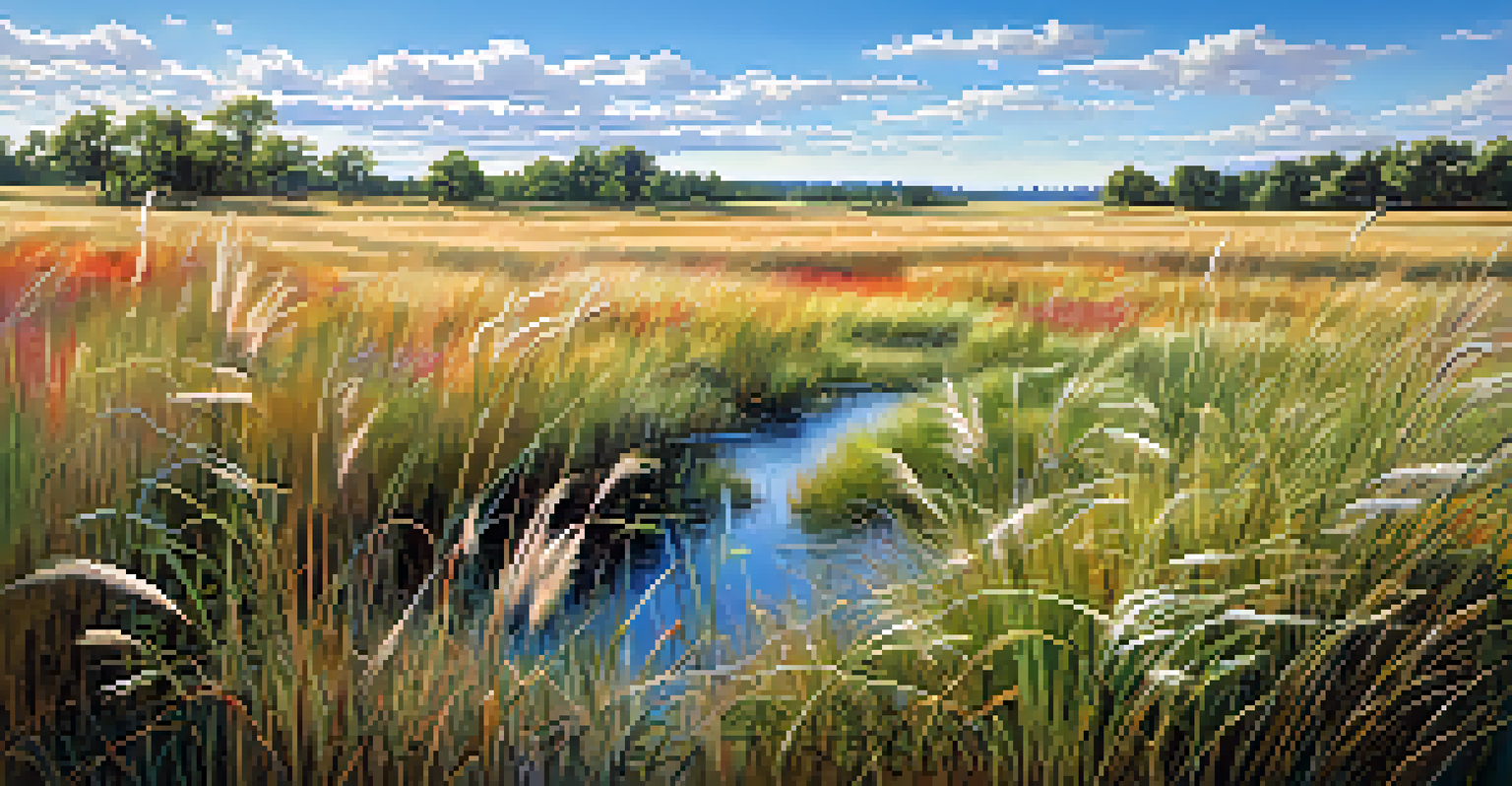Types of Plants Most Effective in Carbon Sequestration

Understanding Carbon Sequestration and Its Importance
Carbon sequestration is the process of capturing and storing atmospheric carbon dioxide. It's vital for combating climate change, as excess CO2 contributes to global warming. By enhancing natural processes, we can reduce greenhouse gases and improve air quality.
The clearest way into the Universe is through a forest wilderness.
Plants play a crucial role in carbon sequestration. Through photosynthesis, they absorb CO2 and convert it into oxygen, storing carbon in their biomass and soil. The more effectively plants can perform this function, the greater their impact on the environment.
Different plants have varying abilities to sequester carbon, influenced by their growth rate, size, and lifespan. In this article, we'll explore the types of plants that are most effective at this process, highlighting their unique benefits and contributions.
Trees: The Heavyweights of Carbon Sequestration
Trees are often seen as the champions of carbon sequestration. Due to their large biomass and long lifespan, they can store significant amounts of carbon over decades or even centuries. A mature tree can absorb about 48 pounds of CO2 per year, making them invaluable in the fight against climate change.

Species like oak, redwood, and sequoia are particularly effective, as they grow tall and wide. Their extensive root systems also help in storing carbon in the soil. Furthermore, forests, which are composed of many trees, create a substantial carbon sink, enhancing their overall impact.
Plants are vital for carbon capture
From trees to grasses, various plants play a crucial role in capturing and storing atmospheric CO2, helping combat climate change.
To maximize the benefits, it's essential to protect existing forests and promote reforestation efforts. By planting more trees and ensuring their survival, we can significantly bolster our carbon sequestration efforts and contribute to a healthier planet.
Grasses: The Unsung Heroes of Carbon Storage
While trees often steal the spotlight, grasses are also powerful players in carbon sequestration. Grasslands, particularly those with deep-rooted species, can sequester large amounts of carbon in their extensive root systems. This underground storage is often overlooked but is crucial for soil health and stability.
He that plants trees loves others besides himself.
Perennial grasses like switchgrass and big bluestem are especially effective, as they grow back year after year without the need for replanting. Their deep roots not only capture carbon but also improve soil structure and prevent erosion, making them a sustainable choice for land management.
In addition to their carbon-storing capabilities, grasslands provide habitats for various wildlife. By maintaining healthy grasslands, we not only support biodiversity but also enhance our efforts in carbon sequestration, demonstrating the interconnectedness of ecosystems.
Wetlands: Nature's Carbon Sinks
Wetlands are among the most efficient ecosystems for carbon sequestration. These areas, which include marshes, swamps, and bogs, store carbon in both plant biomass and the saturated soil beneath them. The waterlogged conditions slow down the decomposition of organic matter, leading to significant carbon accumulation.
Plants such as mangroves, salt marsh grasses, and sedges excel in these environments. For instance, mangrove forests can sequester carbon at rates up to four times higher than terrestrial forests. Their unique adaptations allow them to thrive in saline conditions while effectively capturing CO2.
Wetlands are natural carbon sinks
Wetlands like marshes and mangroves efficiently sequester carbon due to their unique ecosystems that slow down decomposition.
Protecting and restoring wetlands is essential for enhancing their carbon storage capabilities. By prioritizing wetland conservation, we can not only combat climate change but also safeguard vital habitats that support diverse species.
Cover Crops: Enhancing Soil Carbon Sequestration
Cover crops, like clover and rye, are often used in agriculture to improve soil health, but they also play a significant role in carbon sequestration. By planting these crops during off-seasons, farmers can enhance soil organic matter and capture additional carbon from the atmosphere. This practice not only benefits the soil but also contributes to climate change mitigation.
When cover crops decompose, they release stored carbon back into the soil, enriching it and improving its fertility. This cycle of growth and decomposition creates a sustainable model for carbon storage while providing farmers with healthier soil for future crops.
Integrating cover crops into farming practices can lead to a win-win situation: reduced carbon emissions and increased agricultural productivity. By adopting such practices, farmers can become vital contributors to carbon sequestration efforts.
Perennial Plants: Long-Term Carbon Storage Solutions
Perennial plants, which live for more than two years, offer a sustainable solution for carbon sequestration. Unlike annual plants that require replanting, perennials develop extensive root systems that store carbon year after year. This long-term growth allows them to capture significant amounts of CO2 consistently over time.
Examples of effective perennial plants include certain varieties of wheat, sorghum, and even flowering plants like coneflowers. These species not only sequester carbon but also contribute to biodiversity, providing habitats for pollinators and other wildlife.
Urban greening boosts carbon efforts
Incorporating more greenery in cities through trees and plants helps offset CO2 emissions while improving air quality and urban environments.
By promoting the use of perennial plants in agriculture and landscaping, we can create resilient ecosystems that enhance carbon capture while supporting a diverse range of flora and fauna.
Urban Plants: Greening Cities for Carbon Capture
Urban areas account for a significant portion of global CO2 emissions, making urban plants crucial in carbon sequestration efforts. Trees, shrubs, and even green roofs can help offset emissions by capturing carbon and improving air quality. Incorporating more greenery in cities not only aids in carbon capture but also enhances the overall urban environment.
Species like London plane trees and red maples are popular choices for urban landscapes due to their resilience and carbon-absorbing capabilities. Planting these trees in parks, along streets, and on rooftops can create green corridors that support wildlife while sequestering carbon.

Encouraging community involvement in urban greening initiatives can amplify these efforts. By fostering a culture of planting and caring for urban plants, cities can significantly contribute to carbon sequestration and promote a healthier, more sustainable living environment.
Conclusion: The Path Forward in Carbon Sequestration
As we have explored, various types of plants play critical roles in carbon sequestration. From towering trees to resilient grasses and essential wetlands, each plant type has unique benefits that contribute to reducing atmospheric CO2 levels. Understanding and leveraging these natural solutions is vital in our fight against climate change.
It's important to adopt practices that support the growth and preservation of these plants. Whether through reforestation, sustainable agriculture, or urban greening, our collective efforts can lead to meaningful change. Every action counts, and together, we can make a significant impact.
As we move forward, fostering a deeper appreciation for the plants that help our planet is essential. By prioritizing their conservation and integrating them into our daily lives, we can create a greener, healthier world for generations to come.